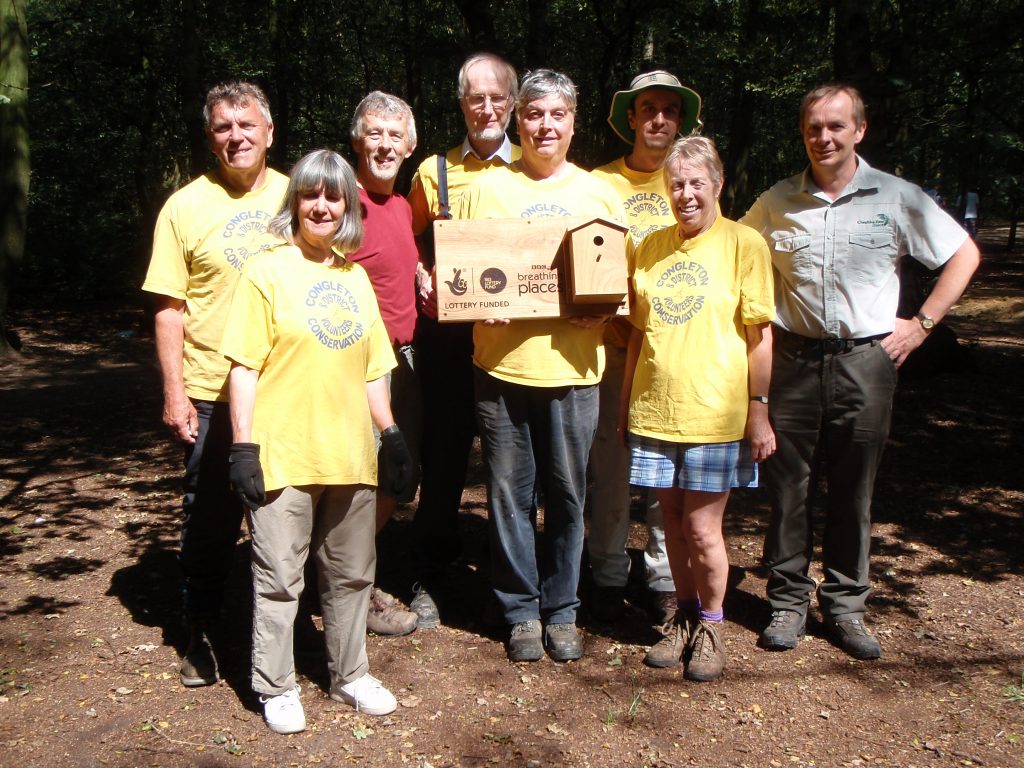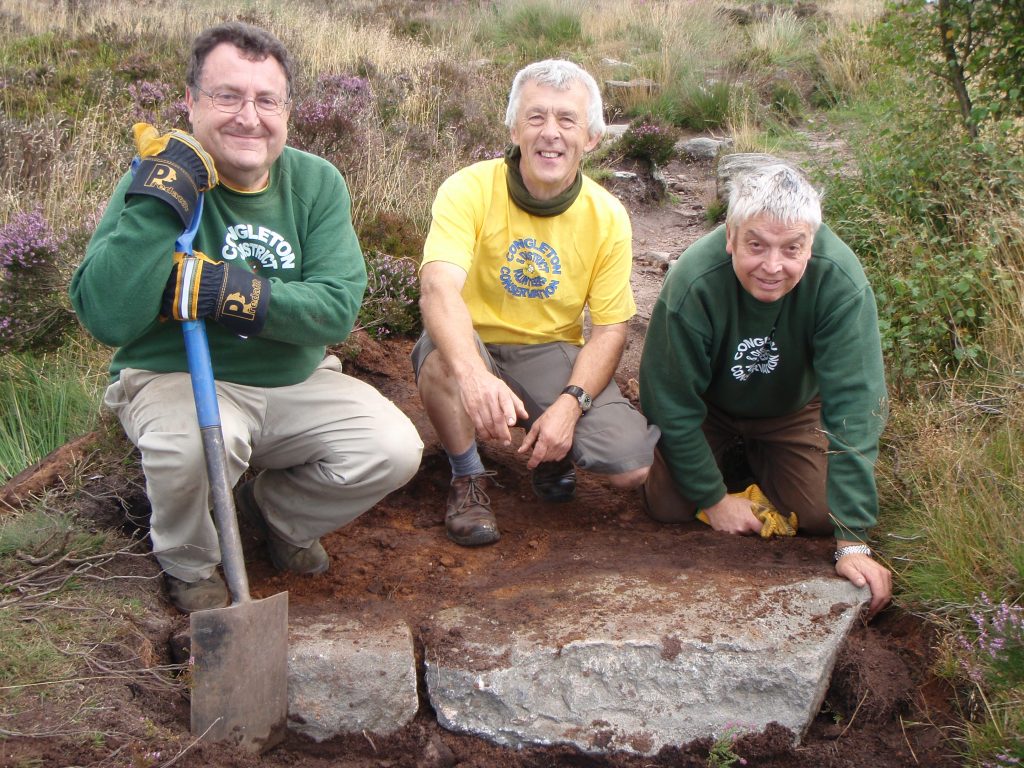Brimstone Pond Project
Congleton & District Conservation Volunteers were awarded a grant from the Big Lottery Breathing Spaces programme to restore two wildlife ponds at Brereton Heath Local Nature Reserve.
At the end of April 2009 diggers moved into the south west corner of the Nature Reserve to excavate the ponds. The site, a former sand pit, had silted up over time and only held water during very wet periods. The new ponds will be a permanent attraction for wildlife attracting a range of amphibian and invertebrate life. The pond will also be used for educational purposes including pond dipping sessions with school groups. This was the culmination of twelve months of planning following the award of the grant.

Over the following few months a path and viewing area were created to provide access for visitors. The group have adopted the area and over the next few years will seed and plant the area with wild flowers and native trees and shrubs and maintain it to further improve biodiversity.
We have named the pond the “Brimstone Pond” in keeping with the Brimstone trail that runs through the Brereton Country Park.
Wetlands
The group works at several mosses, or bogs, most of which have deposits of peat and are colonised by Sphagnum moss. Conservation of these sites is increasingly important, as an estimated 97% of lowland bogs in England and Wales have been damaged or destroyed.  They support butterflies such as the Small Pearl Bordered Fritillary and the Green Hairstreak and plants such as Sundew, Cranberry and Cross-leaved Heath as well as dragonflies and damselflies. Most are sites of Special Scientific Interest and not all are accessible to the general public.
They support butterflies such as the Small Pearl Bordered Fritillary and the Green Hairstreak and plants such as Sundew, Cranberry and Cross-leaved Heath as well as dragonflies and damselflies. Most are sites of Special Scientific Interest and not all are accessible to the general public.
We preserve these habitats by removing invading vegetation such as birch, bramble and rhododendron; wellies are a must!
Path rebuilding at Borrow Pit
We rebuilt the edge of a stretch of footpath near the Borrow Pit site in Alsager. This is a former landfill site which has been capped, planted and laid out with a circuit of footpaths. The footpaths have been created using a clayey-sand mix bordered on both sides by wooden boards. Some of the boards have moved, causing the edge of the path to start to collapse. For this task we first cleared a trench along the edge of the path and inserted new boards behind the old ones. These were held in place by wooden stakes. We then refilled the trench with earth and hardcore and finally resurfaced the edge of the path. We completed about 100 feet in the day’s task.
Footpath restoration at the Cloud
The footpath leading up to the summit of The Cloud has been used since Victorian times. In those days people used to walk up in their Sunday best. Today it’s more casual clothing and walking boots. Not surprisingly the path has become badly eroded over the years and the inclement weather often experienced on The Cloud hasn’t helped. This has been a continuing task for us over a number of years. Our objective is to rebuild the stone steps on one of the paths to the summit. These steps are placed around 5 metres apart and the idea is to reset them so that rain washes a sandy bed behind each step. This levels the path between steps and makes it easier to walk on. Many of the stones in the steps have been displaced and have to be reset. Some are extremely heavy!


Hedgelaying Project
Congleton & District Conservation Volunteers was formed in 1990. The aims of the group are to promote practical conservation through volunteers, maintaining and improving the countryside and improving access for the public. Since 1990 they have worked on a number of sites across East Cheshire.
Three of the many activities undertaken by the group involve tree planting and the traditional crafts of hedgelaying and coppicing
Coppicing is a woodland management technique that dates back to the Stone Age and was originally used to ensure a regular source of firewood and timber. Traditionally, the long straight poles produced by coppicing would have been used for fencing, building, stakes for hedge laying and in the garden as bean poles. It involves felling trees at their base to create a ‘stool’ where new shoots will grow. You can recognise a coppiced tree by the many thin trunks or ‘poles’ at its base. Most tree species can be coppiced but the best suited of our native trees are hazel, sweet chestnut, ash and lime.
These days, coppicing is primarily a way of improving the health and biodiversity of a woodland area by opening it up to the sunlight and allowing a wider range of plants to flourish.
Hedgelaying is the process of partially cutting through far enough leaving sufficient cambium and sapwood uncut to allow the “pleacher” to survive. The stems of a line of shrubs or small trees are then bent, near ground level, without breaking them to create a living fence and encourage them to produce new growth from the base. Hedgelaying developed as a way of containing livestock in fields, particularly after the acts of enclosure which, in England, began in the 16th century. After the Second World War the demand for food created a major change in agricultural techniques, hedgerows were no longer considered of any value. Hedgelaying was a costly and unnecessary process which could be replaced simply and cheaply by running barbed wire around a field, attaching it to any tree or shrub that was available. Tractor mounted flails were introduced which could trim a hedgerow to manageable proportions very easily.
Hedges can provide fabulous shelter and safe corridors for movement – “wildways”. Their value for this is enhanced considerably if they’re laid and allowed to breathe. Toads, other amphibia and reptiles find their dense, damp cover helpful. Birds are attracted by the insects, berries and nuts that a dense hedge provides, but also benefit from the protection of larger, denser hedges. They’re a great substitute for the wood pasture or woodland edge habitat that’s so rich in biodiversity.
One of the group’s projects sees all of the above activities being brought together.
The project began in 2017 when the group planted approximately 200 metres of hawthorn hedging at Borrow pit Meadows, Alsager, on the easy access trail.

Last November the group coppiced hazel in a small woodland that they had also helped to plant.

From the cut stems stakes were made to be used on the hedge.

In January this year the group then began their latest project to lay the hedge

The hedge for laying is prepared by cutting out overlapping branches to free each tree to be laid.

The process of partially cutting through to create “pleacher”.

The stems are then bent, near ground level, without breaking them to create a living fence and encourage them to produce new growth from the base.

The group will be back later in the year to continue with the hedgelaying.
The correct management of hedgerows is vital if they are to survive and be healthy enough to provide a good habitat and encourage new growth that starts a new life cycle of the hedge. Over-management by hard trimming to the same height each year will ultimately degrade the hedge so it is hollow at the base and provide little shelter for wildlife. At the other extreme neglecting a hedge will allow it to become tall and overgrown, eventually even to collapse.
Hedgelaying preserves the past and protects the future.



